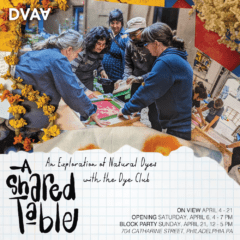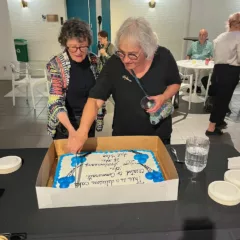By Diana Jih
Somewhere between the Matterhorn and Mt. Fuji, Hiro Sakaguchi and I are teetering on the left wing of a 747 with paint cans and packs of brushes. As the wind picks up, I brace myself by pulling on a thin climbing rope tethered to a snow bank in the clouds. Hiro senses my panic, spins around, and acknowledges with a nod that although in this dream I am having we appear like Sir Edmund Hillary and Tenzing Norgay, neither of us knows how to climb a mountain. CRASH. Awake and relieved, I spend the rest of my day mourning for Hiro-drawn dreams inspired by his evocative exhibition at PAFA.
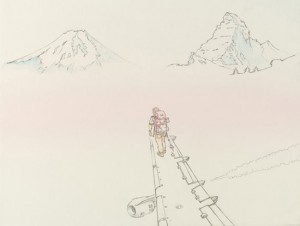
No Particular Place to Go , Sakaguchi’s new solo exhibition at the Morris Gallery at the Pennsylvania Academy of Fine Arts (PAFA), greets you at the bow of PAFA’s historic Frank Furness building. The April First Friday opening welcomed attendees into Sakaguchi’s headspace, memories and dreams. On an especially rainy night the crowd found itself shipwrecked on the shore of an unmappable island in a sea of childhood whimsy, adventure, and violence. Captain Hiro’s installation, “Hibachi Engine Boat,” exults these themes with its perfectly imprecise translation from dream to line drawing to three-dimensional sculpture.
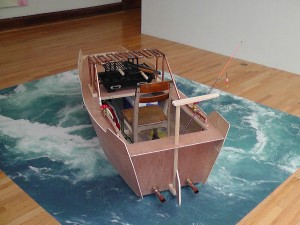
The blonde wood boat with bright copper piping, seemingly powered by a hibachi grill, sits over a digital blow-up of churning ocean waves. The idea for the slightly-too-small-for-you boat comes from Sakaguchi’s playing with paraffin-powered boats as a child (no, he hasn’t seen Ponyo, the 2008 Japanese animated fantasy film with a marine theme). It also has to do with his fascination with battle-boat animations and with his trip to 2008’s South Philly Boat Show, an art exhibit loosely on the theme of boats. The result: the 2009 drawing, “A Boat with Pin Wheel & Hibachi Engine,” and 2011’s “Hibachi Engine Boat.”
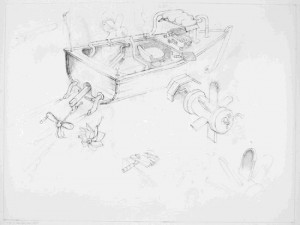
The piece references his experience with grills in Japan, where they are used primarily for hand-warming, and in America, where they are used for tailgating and cooking outdoors. The latter use is represented by empty beer cans and fishing poles around the hibachi.
Some wonder about connections the piece has to the recent tsunami in Japan, which actually post-dates the sculpture. Sakaguchi talked about how the sleeping/dreaming mind conjures up images and how the piece opens up multiple memories and narratives fueled by the image of swirling water and the boat.
His deference to dreams in various media elevates chance and the unknown to a level akin to the Surrealists. There is even chance in the artist’s translation of the boat from drawing to engineered and semi-functional sculpture, where chance/logistics were allowed to play a part in the creative process. Like other Surreal works, “Hibachi Engine Boat” uses realism as a deception. It looks real but is an absurd and unreal object.
Sakaguchi mentioned to me while I was visiting his show that he admires Rene Magritte’s clever juxtapositions and sense of humor. His own playfulness proves equally admirable and useful. And, like another Surrealist, Dorothea Tanning, he uses children’s toys to deal with ideas of violence.
The artist’s adventures are full of a comic book aesthetic. One piece — which references the Xanthus Smith Civil War painting upstairs at PAFA as well as contemporary graphic art — embodies both irreverence and reverence for the PAFA tradition of studying the old masters for inspiration. Sakaguchi is a PAFA grad and now teacher at the Academy.
Julien Robson, Contemporary Art Curator at the museum, told me he characterizes artists like Sakaguchi as belonging to the art historical “timeline” stretching back hundreds of years. Sakaguchi,upon hearing this, humbly says “Wow”. PAFA will continue to celebrate the timeline with shows like this of contemporary artists, says Robson, though the museum is a big institution with many different constituencies and missions and “a big ship takes a long time to turn.”
Robsen and Sakaguchi compare and reminisce about childhood’s toys and tv shows, marveling in the commonalities and differences. At one point they belt out a chorus together of the opening theme song to Thunderbirds, a mid-1960s British sci-fi show clearly special to both of them. When visiting Sakaguchi’s worlds, you, too, can remember the toys and illustrations of childhood and place yourself in his adventures and see where you fit.
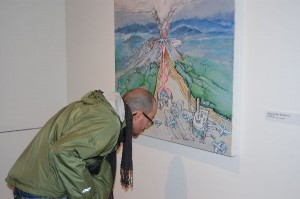
No Particular Place to Go remains on view through August 28 at the Pennsylvania Academy of the Fine Arts, Morris Gallery, 118 N. Broad St.



